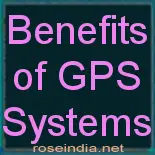Benefits of GPS Systems
Introduction
GPS or Global Positioning System was originally developed as a military navigation tool. However the technology has grown along with a sub set of supporting technologies to serve other requirements within consumer budgets.
The principle behind GPS is very simple- it works by providing a set of geographical coordinates such as a place’s latitude, longitude and elevation on Earth. The GPS device also gives out very accurate time.
The basic functionality of GPS technology is limited to receiving satellite signals and calculating position information. Things like navigation systems, tracking devices, surveying and mapping instruments are simply different applications of the technology.
How GPS Works
GPS produces results similar to the traditional ‘triangulation’ method used in military navigation. In triangulation, a navigator uses a minimum of three points that they recognize in the world to specify his location on the map. This was done earlier using a compass. The azimuth (the direction of a celestial object which is measured clockwise around the observer’s horizon, starting north) that would be required to take the user from the specified point on the map to their current location was calculated. This way lines were drawn from three pre defined points, and the point where the three lines meet was taken as the user’s location on the map.
In GPS technology, the predefined points are replaced with satellites and the azimuth is calculated using the time taken for signals to travel from each of the satellite to the GPS receiver. The location is obtained as the intersecting point of the circles that represent the distance from each satellite. To account for any time difference between the GPS locator and the satellite, signals from a fourth satellite are also brought into account.
The real calculation process is far more complex than this, as the system has also to account for atmospheric distortion of the signals. However the basic principle is the same as the compass method.
The application of GPS technology can be broadly divided into two categories: 1.tracking devices and 2.navigation systems .
GPS in Tracking
GPS tracking devices are the simplest form of this technology; they can also be used in combination with communication technologies like radio transmission and telephony. With tracking, a tracking center can monitor the movements of several vehicles or people in real time. These may be criminals, military and police personnel or young children whose parents need to keep an eye on them while they are away.
In all these cases, the tracking set up has a GPS receiver, GPS software and a device to transmit the resulting co-ordinates, such as GPS watches or cell phones that transmit radio waves.
GPS in Navigation
Once a user is located through GPS, the location can be identified on a map. This is useful for tasks like locating a unit, finding a route from point A to B or selecting a suitable route in real time.
However navigation requires map work and this is not part of GPS systems. Therefore mapping has to be done using associated technologies which often necessitate the use of portable computers and such gadgets.
The applications here range from simple car navigation systems to highly sophisticated packages for aviation and marine navigation and even GPS solutions for use on the golf course!



